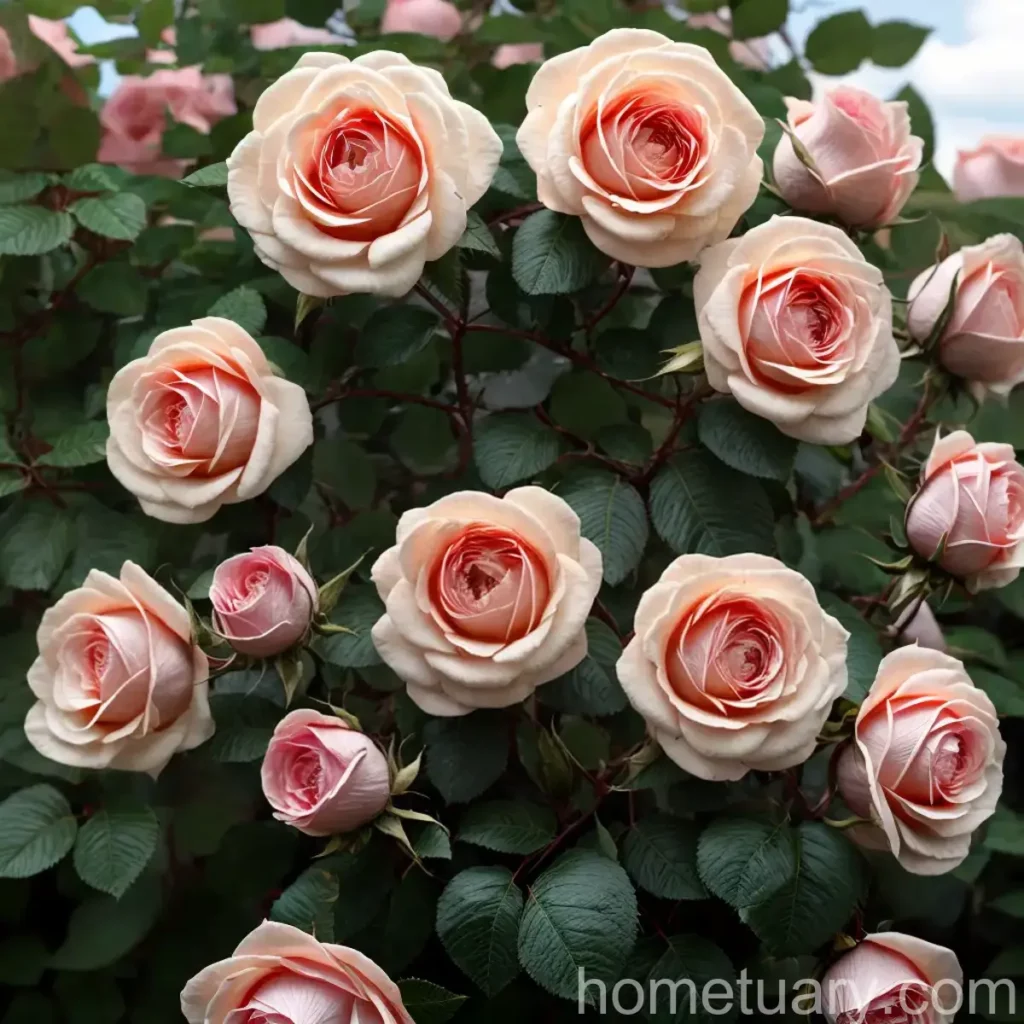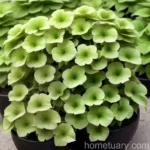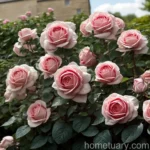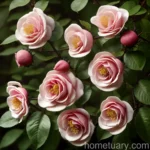Shrub Rose (Rosa ‘Ausday’ THE ALEXANDRA ROSE)
In the world of gardening, few plants hold the same level of romance and allure as the classic rose. With their timeless beauty, delicate fragrance, and rich symbolic history, roses are a staple in gardens around the world. Among the diverse range of rose varieties, the shrub rose stands out for its hardiness, ease of care, and remarkable beauty. In this comprehensive guide, we will delve into the world of shrub roses, with a particular focus on the enchanting Rosa ‘Ausday’ The Alexandra Rose.
What is a Shrub Rose?
Shrub roses, also known as landscape roses, are a diverse group of rose species and cultivars that encompass a wide range of growth habits, bloom types, and hardiness. Unlike traditional hybrid tea roses, which are often associated with high maintenance and specific care requirements, shrub roses are valued for their resilience, disease resistance, and ability to thrive in various environmental conditions. These versatile plants are renowned for their bushy, spreading growth habit, which makes them ideal for use as hedges, borders, and mass plantings, as well as standalone specimens in garden beds and containers.
Shrub Rose Cultivar: Rosa ‘Ausday’ The Alexandra Rose
Rosa ‘Ausday’ The Alexandra Rose, commonly referred to as The Alexandra Rose, is a stunning shrub rose cultivar that has captured the hearts of gardeners and rose enthusiasts alike. Bred by David Austin Roses in the United Kingdom, this exceptional variety is celebrated for its classic beauty, delightful fragrance, and robust growth. With its alluring combination of old-fashioned charm and modern garden performance, The Alexandra Rose has established itself as a beloved choice for both novice and experienced gardeners.
Key Takeaways – Shrub Rose (Rosa ‘Ausday’ THE ALEXANDRA ROSE)
Before delving into the specific care and cultural requirements of The Alexandra Rose, let’s highlight some key takeaways that will guide our exploration of this enchanting shrub rose cultivar.
Key Takeaways:
- The Alexandra Rose is a shrub rose cultivar renowned for its classic beauty and delightful fragrance.
- This variety is a product of David Austin Roses, known for breeding roses with exceptional garden performance.
- The resilience and disease resistance of The Alexandra Rose make it well-suited for various environmental conditions and gardening applications.
- As a landscape rose, The Alexandra Rose offers versatility and can be used as a standalone specimen, in mass plantings, or as a hedge or border plant.
Now that we have established an overview of The Alexandra Rose, let us delve into the specific cultural considerations for successfully growing and caring for this exceptional shrub rose.
Culture
The proper cultural practices are essential for nurturing healthy and vibrant shrub roses. A good understanding of a plant’s cultural requirements ensures that it will thrive and produce an abundance of beautiful blooms. When it comes to The Alexandra Rose, there are several key factors to consider in its cultivation.
Uses
The Alexandra Rose offers a wide array of uses in the garden, thanks to its versatile growth habits and enchanting aesthetics.
- Garden Beds: Plant The Alexandra Rose as a standalone specimen in garden beds to showcase its stunning blooms and fragrance.
- Mass Plantings: Create striking displays of color and fragrance by planting multiple specimens of The Alexandra Rose in mass plantings.
- Hedges and Borders: Utilize The Alexandra Rose to create decorative hedges or borders, adding elegance and charm to the garden landscape.
- Container Planting: The compact growth habit of The Alexandra Rose makes it well-suited for container gardening, allowing it to grace patios, balconies, and other outdoor spaces with its beauty.
Water
Proper watering is crucial for the health and vitality of shrub roses, including The Alexandra Rose. While these plants are relatively drought-tolerant once established, consistent and adequate watering is essential, especially during the active growing season and flowering period. Maintaining moist, well-drained soil will help The Alexandra Rose thrive and produce an abundance of blooms.
- Watering Tips:
- Frequency: Water deeply once or twice a week, ensuring that the soil is evenly moist but not waterlogged.
- Mulching: Apply a layer of organic mulch around the base of the plant to retain soil moisture and suppress weed growth.
- Avoid Overhead Watering: Minimize wetting the foliage, as this can contribute to the development of fungal diseases.
Sunlight
Like most roses, The Alexandra Rose thrives in bright sunlight and requires ample sun exposure to bloom abundantly and maintain healthy growth. When selecting a planting site for The Alexandra Rose, prioritize locations with full sun exposure, which typically means at least six hours of direct sunlight per day.
- Sunlight Requirements:
- Optimal Sun Exposure: Choose a planting site that receives full sun for the majority of the day, ensuring that The Alexandra Rose receives the necessary light for vigorous growth and prolific flowering.
Fertilizer
Proper nutrition is essential to support the growth, flowering, and overall health of shrub roses such as The Alexandra Rose. Regular fertilization helps replenish soil nutrients and ensures that the plant has access to the essential elements it needs for robust growth and abundant blooms.
- Fertilizer Recommendations:
- Balanced Fertilizer: Apply a balanced fertilizer formulated for roses or flowering shrubs in early spring, just as new growth begins.
- Organic Amendments: Incorporate organic matter such as well-rotted compost or aged manure into the soil to enhance fertility and promote beneficial soil microorganisms.
Soil
The quality and composition of the soil play a significant role in the successful cultivation of shrub roses. The Alexandra Rose thrives in well-drained, fertile soil with good structure and a slightly acidic to neutral pH level.
- Soil Considerations:
- Well-Drained Soil: Ensure that the planting site has well-drained soil to prevent waterlogging, which can lead to root rot and other issues.
- Soil Amendment: Prior to planting, amend the soil with organic matter to improve its structure and fertility, providing an optimal growing environment for The Alexandra Rose.
Pruning
Pruning is an essential practice for maintaining the shape, health, and flowering performance of shrub roses, including The Alexandra Rose. Proper pruning encourages vigorous new growth, removes dead or diseased wood, and shapes the plant to enhance its aesthetic appeal.
- Pruning Guidelines:
- Timing: Prune The Alexandra Rose in late winter or early spring, before the onset of new growth.
- Deadheading: Regularly remove spent blooms to stimulate continuous flowering and prevent the formation of hips.
- Pruning Techniques: Utilize sharp, clean pruning shears to make angled cuts just above outward-facing buds or leaf nodes, promoting outward growth and an open, airy structure.
Propagation
The propagation of The Alexandra Rose allows gardeners to expand their collection of these captivating shrub roses. While propagation methods such as stem cuttings and layering are common, The Alexandra Rose can also be propagated through grafting onto suitable rootstock.
- Propagation Methods:
- Semi-Hardwood Cuttings: Take semi-hardwood cuttings in late summer or early autumn, using young, healthy stems to propagate new plants.
- Layering: Encourage the formation of roots on a lower stem by bending it down to the ground and covering it with soil, allowing it to develop into a new plant.
- Grafting: Utilize grafting techniques to propagate The Alexandra Rose by joining a desirable scion onto a compatible rootstock, ensuring the resulting plant inherits the desired traits and vigor.
Container Popularity
The compact growth habit and ornamental appeal of The Alexandra Rose make it a popular choice for container planting. Whether on a patio, balcony, or terrace, this shrub rose brings classic beauty and fragrance to container gardens, allowing it to thrive in smaller spaces.
- Container Gardening Tips:
- Well-Draining Containers: Select containers with adequate drainage holes to prevent waterlogging and promote healthy root development.
- Quality Potting Mix: Use a high-quality potting mix designed for flowering plants, providing essential nutrients and good aeration for the roots of The Alexandra Rose.
Common Diseases
Despite their resilience and disease resistance, shrub roses, including The Alexandra Rose, are susceptible to certain fungal, bacterial, and viral diseases. Recognizing the symptoms and implementing preventative measures is crucial for maintaining the health and vigor of these plants.
Disease Diagnosis
Common diseases that may affect The Alexandra Rose include powdery mildew, black spot, and botrytis blight, among others. Regular monitoring and prompt intervention are essential for identifying and addressing potential disease issues before they compromise the plant’s health and vitality.
- Symptoms to Watch For:
- Powdery Mildew: White, powdery patches on leaves and stems, often accompanied by leaf distortion and stunted growth.
- Black Spot: Circular black or dark brown spots on the foliage, leading to premature leaf drop and reduced vigor.
- Botrytis Blight: Gray mold affecting flowers and foliage, often triggered by prolonged periods of high humidity and poor air circulation.
Common Pests
In addition to diseases, shrub roses are susceptible to pest infestations that can affect their growth and flowering. Common pests, such as aphids, thrips, and spider mites, can pose a threat to The Alexandra Rose if left unchecked.
- Pest Management Strategies:
- Natural Predators: Encourage beneficial insects and predators that feed on common pests, helping to maintain a natural balance in the garden.
- Horticultural Oils: Apply horticultural oils to suffocate and control common pests, reducing their populations without harming beneficial insects and pollinators.
Botanist’s Tips
As a plant scientist with a passion for shrub roses, I have compiled a set of valuable tips and insights to help you cultivate and enjoy The Alexandra Rose to its fullest potential.
Fun Facts
- Historical Significance: The Alexandra Rose is named in honor of Alexandra of Denmark, known as the queen consort of the United Kingdom from 1901 to 1910. This variety pays homage to her grace and timeless elegance.
- Fragrance Profile: The fragrance of The Alexandra Rose is reminiscent of old rose and myrrh, delighting the senses with its rich and captivating aroma.
- Breeding Legacy: Bred by David Austin Roses, The Alexandra Rose is a testament to the ongoing commitment to developing exceptional shrub rose varieties with classic beauty and modern performance.
Links to External Resources
For further exploration of shrub roses, rose gardening, and The Alexandra Rose, I recommend the following resources:
-
American Rose Society: The American Rose Society is a leading organization dedicated to the culture and appreciation of roses, offering a wealth of information for rose enthusiasts.
-
Royal Horticultural Society: The Royal Horticultural Society provides comprehensive guidance on growing roses, including shrub roses, and hosts educational events and showcases for rose lovers.
-
David Austin Roses: Explore the official website of David Austin Roses to discover the full range of exceptional rose varieties, including The Alexandra Rose, along with valuable gardening advice and inspiration.
-
University Extension Services: Many university extension services offer in-depth guides and publications on rose care, disease management, and best practices for shrub rose cultivation.
-
Rose Hybridizers Association: Delve into the world of rose hybridization and connect with experts and enthusiasts who are passionate about creating new and exceptional shrub rose varieties.
By leveraging these resources and the insights shared in this comprehensive guide, you will be well-equipped to cultivate and enjoy the timeless beauty and sophistication of The Alexandra Rose in your garden.
Conclusion
In conclusion, shrub roses, with their remarkable resilience, captivating beauty, and delightful fragrance, hold a special place in the hearts of gardeners and rose enthusiasts. Among these enchanting roses, the Rosa ‘Ausday’ The Alexandra Rose stands out as a timeless exemplar of classic elegance and modern garden performance. Through proper care and attention to its cultural requirements, including watering, sunlight, fertilizer, soil, pruning, and propagation, you can cultivate The Alexandra Rose to its fullest potential, creating a captivating display of blooms and fragrance in your garden.
As we have explored the enchanting world of shrub roses, particularly The Alexandra Rose, I hope you have gained valuable insights and inspiration for your own gardening endeavors. The allure and historical significance of The Alexandra Rose, paired with its exceptional characteristics and ease of care, make it a standout choice for any garden, offering timeless beauty and fragrance for generations to come.
Remember, whether you are a novice gardener or an experienced horticulturist, the joy of cultivating shrub roses such as The Alexandra Rose lies in the journey of discovering their remarkable beauty and creating a space where nature’s elegance flourishes.
Happy gardening!
References
American Rose Society. Understanding Rose Classifications. https://www.rose.org/understanding-rose-classifications
Royal Horticultural Society. Growing Roses. https://www.rhs.org.uk/advice/profile?pid=265
David Austin Roses. The Alexandra Rose. https://www.davidaustinroses.com/us/products/the-alexandra-rose
University of Maryland Extension. Roses. https://extension.umd.edu/hgic/topics/roses
Rose Hybridizers Association. https://www.rosehybridizers.org/
Plant Name: “shrub rose (Rosa ‘Ausday’ THE ALEXANDRA ROSE”)















